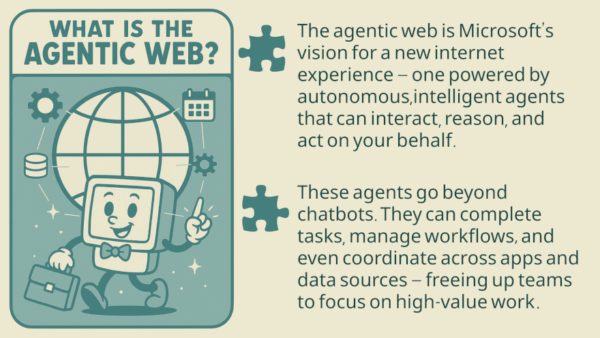
With 2025 well underway, the pressure on small and midsize businesses continues to grow — to deliver faster, operate leaner, and adapt with fewer resources. Automation has become the lever smart teams are using to stay ahead of that curve.
The most successful SMBs aren’t just buying new tools; they’re streamlining processes, connecting their systems, and using automation to give their teams more time for the work that matters.
Below are five practical ways to automate your operations — without over-engineering, over-hiring, or slowing down.
No-code and low-code platforms let businesses build automations and workflows using drag-and-drop logic — no traditional programming required. Tools like Power Automate, Zapier, and Make make it easy to automate approvals, notifications, CRM updates, and more.
These platforms are fast, flexible, and user-friendly — perfect for getting quick wins and validating ideas without long dev cycles.


No-code is faster and cheaper — but only works well when you know how to use it. Traditional coding is more powerful — but slower and costlier. The smartest teams use both.
Your internal team or strategic partner can help identify where no-code makes sense — and where traditional engineering is the better choice.
The rise of the “agentic web,” as described by Microsoft CEO Satya Nadella, is reshaping how work gets done — not just through apps, but through intelligent agents that take action on our behalf.
AI-powered assistants are changing how small businesses handle knowledge work. With tools like Microsoft Copilot, Azure OpenAI, and custom GPTs, businesses can now automate tasks that require judgment, summarization, or decision support. And with platforms like Microsoft’s Copilot Studio and Azure’s Foundry Agent Service, businesses can now deploy powerful task-completing agents customized to their workflows and tone.

Use AI to:
Done well, this kind of automation reduces busywork and gives teams more focus time.
The right expert team can train and fine-tune AI agents to your domain, workflows, and compliance needs — so automation adds clarity, not risk.
Identify bottlenecks, automate workflows, and build fast.
Get Started TodayIt’s one thing to automate a single task. It’s another to automate an entire process from end to end. Hyperautomation combines AI, robotic process automation (RPA), and workflow orchestration to do exactly that.
Instead of just approving an invoice, you can automate the entire flow: data extraction → validation → approval → entry → reporting.
Common use cases include:
Strategic partners can help map your current workflows, identify waste, and design automation flows that scale smoothly.
Automation isn’t just about doing work — it’s also about seeing it. Real-time dashboards powered by tools like Power BI, Microsoft Fabric, or Dataverse allow your team to track metrics, spot trends, and make decisions without digging through spreadsheets.
These dashboards are especially useful for:
These dashboards automatically update as new data flows in — no manual refreshes or email chains required.
A strategic partner can help design your data model, link your systems, and create dashboards that deliver real business insights — not just pretty visuals.
Most businesses already use multiple platforms: a CRM, a calendar/scheduling tool, one or more messaging and social media platforms, and cloud storage. But these tools rarely talk to each other. That means your team ends up copying, pasting, updating, and checking things manually — which kills efficiency.
The smarter approach? Integrate and automate what you already use.
Popular platforms that support automation include:
Automations can:
“The fastest way to automate isn’t always buying something new — it’s making your current tools work better together.”
A good automation team will look at your existing stack first — and only add tools where they’re needed to unlock flow and insight.
Small businesses don’t need more complexity in 2025 — they need clarity, speed, and control.
The smartest teams are using automation to:
In a world shifting toward the agentic web, automation isn’t just about efficiency — it’s about enabling intelligent systems to work alongside your team. The future of business ops will be powered by agents that don’t just inform — they act.
Ready to uncover where automation can have the biggest impact on your business?
Proactive Technology Management helps SMBs design and deploy automation strategies that save time, reduce friction, and scale with your operations.
Schedule a free consultation with our team to identify your top automation opportunities for 2025 and beyond.
Michael Weinberger is a seasoned technology strategist with over 20 years of hands-on experience designing and implementing custom software solutions tailored to the unique challenges of small to mid-sized businesses. His client-first approach has driven innovation across sectors, including legal, healthcare, finance, and operations—delivering scalable, business-aligned technology that drives measurable growth.
Known for blending visionary software architecture with deep business insight, Michael helps SMBs unlock operational efficiency and market expansion through strategic automation and AI integration. His approach is grounded in frameworks like EOS® and Traction, fostering a culture of accountability, clarity, and execution.
Michael’s work has consistently transformed complex business problems into impactful digital solutions, earning the trust of long-standing clients and positioning him as a reliable partner in digital transformation. His leadership at Proactive Technology Management reflects a commitment to ethical innovation, transparency, and lasting business value.
Identify bottlenecks, automate workflows, and build fast.
Get Started Today